The appropriate width of footpaths will depend on factors that include urban design and pedestrian comfort objectives, land use interaction, available corridor width, and multi-modal level of service (LOS) analysis. The table below has minimum widths that apply to typical conditions.
Generally, wider street furniture zones are required in areas with:
and wider through-route zones are generally required in areas with:
The key point is that width should not be determined solely by estimation of user volumes. Nunns and Dodge (2020) provide a NZ-specific valuation method for increased footpath width based on travel time (a function of footpath crowding) and quality of experience research.[1]
Table: Minimum footpath dimensions
|
Location (place type) |
Maximum flow (p/min)1 |
Zone |
Total (m) |
|||
|
Kerb (m) |
Street furniture if provided2 (m) |
Through route (m) |
Frontage3 (m) |
|||
|
Main Streets: arterial streets in pedestrian districts |
100+ |
0.15 |
2.5 |
3.0+ |
1.0 |
6.65 |
|
Activity Streets: alongside parks, schools and other major pedestrian generators |
80 |
0.15 |
1.5 |
2.4 |
0.75 |
4.8 |
|
Local streets near schools and other activities that generate pedestrian activity |
60 |
0.15 |
1.5 |
1.8 |
0.45 |
3.9 |
|
Commercial/ industrial areas outside the CBD |
||||||
|
Urban connectors (collector streets) |
60 |
0.15 |
0.9 |
1.8 |
0.15 |
3.0 |
|
Local streets in residential areas |
50 |
0.15 |
0.9 |
1.8 |
0.15 |
3.0 |
|
Absolute minimum4 |
0.15 |
0.0 |
1.5 |
0.0 |
1.65 |
|
|
1 Maximum flow volumes are based on a threshold of 33 persons per minute per metre of footpath width – the point where walking speeds are seriously affected. Refer to Pedestrian Comfort Guidance(external link) (Transport for London, 2019) for more information. |
||||||
|
2 Consider increasing this distance where vehicle speeds are higher than 55 km/h. |
||||||
|
3 Frontage zone may need to be wider in residential areas so the through zone is offset from the boundary for driveway safety |
||||||
|
4 Only acceptable in existing constrained conditions and where it is not possible to reallocate road space. |
||||||
The table above is a much-simplified version of Table 3.2 (Road design standards) from New Zealand Standard (NZS) 4404:2010 Land Development and Subdivision Infrastructure[2], using place type nomenclature from the One Network Framework.[3] Note City Hubs are omitted as they will primarily be shared spaces, plazas or other pedestrian priority areas (rather than footpaths). However, NZS 4404 does not clearly describe the concept of footpath zones and the standard must be purchased from NZ Standards. Note also that street furniture, landscaping and inset parking can alternate.
NZS 4121:2001 (Design for Access and Mobility – Buildings and associated facilities) stipulates a 1.2m minimum through width, however this is considered insufficient for people walking side-by-side, encountering users travelling in the opposite direction, or overtaking slower/stopped path users. The 1.2m dimension should be used only for access (eg to bus stops, between path restriction devices, etc).
All new and improved developments should comply with the widths specified in the Table above Also refer to the relevant RCA code of practice, district plan, or NZS 4404 where adopted. Where footpaths have not been provided to a suitable standard in the past, RCAs should develop works programmes to bring them up to a suitable standard.
Where space is limited, the step-by-step process in the flowchart below should be used.
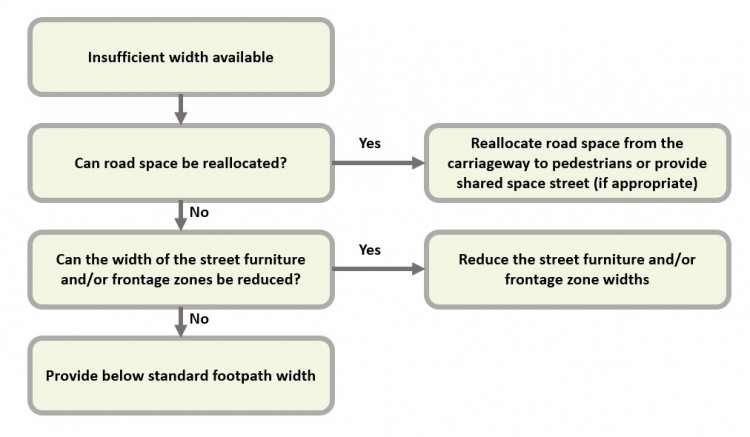
Process for determining footpath provision where width is limited
If an existing footpath needs to be widened as pedestrian flows are higher than the space can accommodate but the footpath zone cannot be widened, then other road space methods may be applicable as outlined below.
I avoid narrow paths because there are so many other people on mobility scooters, if I meet one coming the other way I am screwed. I can't just go around them unless the path is nice and wide so I don't use those paths at all. |
The footpath zone could be extended into the carriageway space if the width is sufficient. This may require car parking removal. Two examples below show how this was achieved.
Example – High Street in Auckland’s central city is a narrow one-way street with parking on both sides and narrow footpaths. The pedestrian volumes are very high so a trial of a wider footpath with removal of the parking lane is being undertaken with a temporary, modular footpath extension and planter boxes. The trial is between Shortland Street to Vulcan Lane in the first phase and is being completed as part of the Innovating Streets programme.
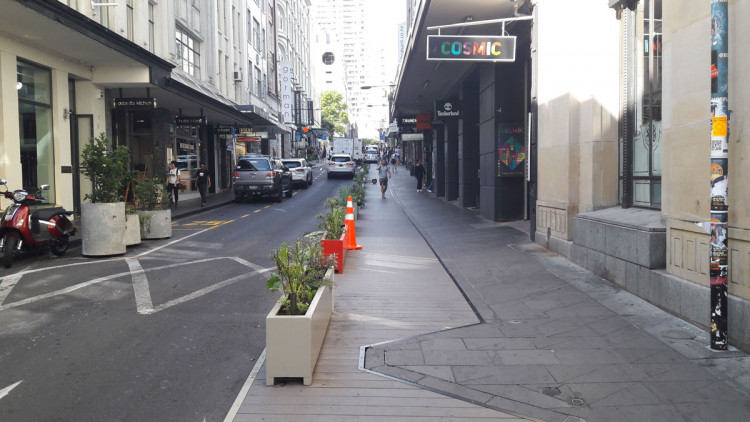
Reallocating parking lane for footpath widening – High Street, Auckland (Jeanette Ward)
This method can be used for outdoor dining area or seating areas, e-scooter and bicycle parking and parklets to allow a clear path for pedestrian movement. Examples are shown below.
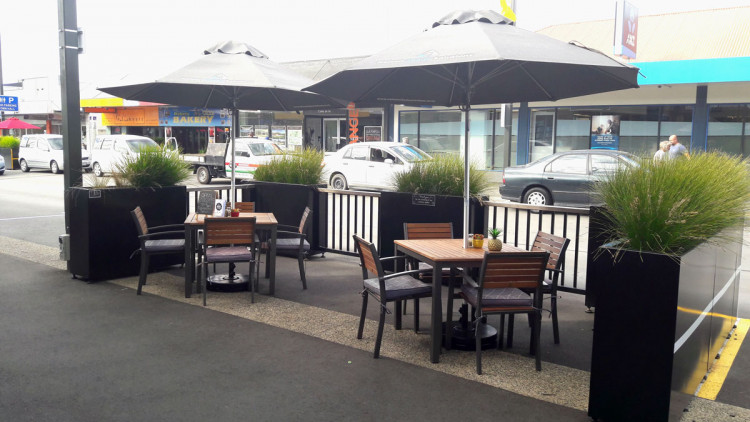
Outdoor café dining area in a parking lane – Queen Street, Richmond (Jeanette Ward)
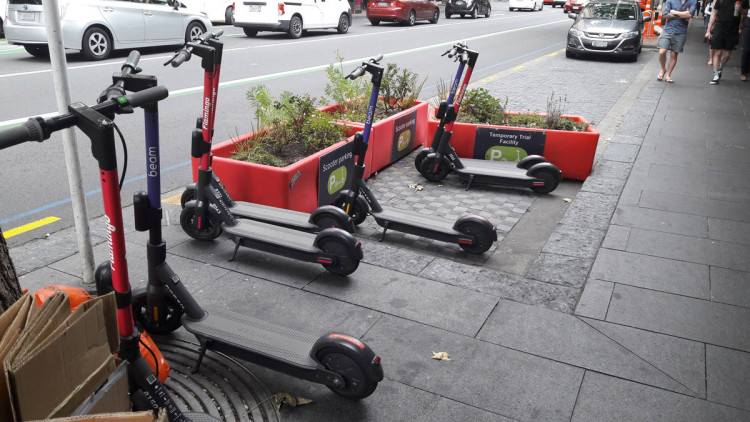
Partial use of the parking lane for e-scooter parking – Queen Street, Auckland (Jeanette Ward)

Bicycle parking in a parking lane – Palmerston North (John Lieswyn)
Where the existing footpath through zone width is constrained to less than 1.8 m wide, passing places should be provided – but only where it is not possible to widen the footpath over a longer distance, and never as a low-cost alternative to a full-width footpath.
Passing places enable:
To allow two wheelchairs to pass comfortably, a clear width of 1.8m is required as shown in the figure below.
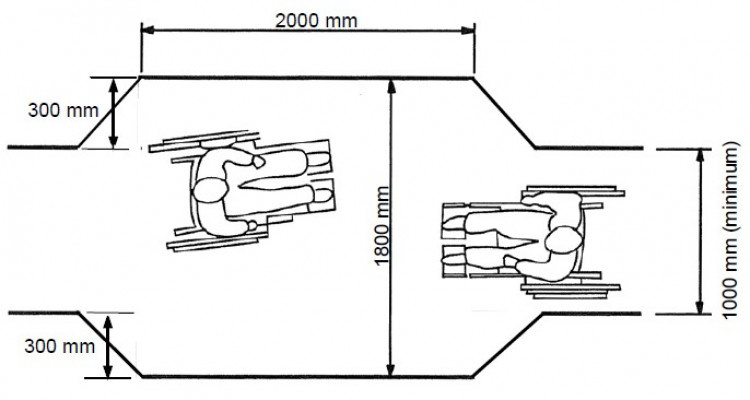
Example of passing areas in constrained locations.[4],
Note the passing area could also be provided by widening by 600mm to one side of the path.
The table below outlines passing place dimensions and spacing.
Table: Installing passing places
| Reason | Passing place dimensions | Location and spacing |
|---|---|---|
| Wheelchair users | Minimum footpath through zone width 1.8m Minimum length 2.0m (see figure above). |
At least every 50 m, and preferably more frequently, where the footpath is less than 1.5m wide. |
| Passing pedestrians | Minimum footpath through zone width 1.8m. Minimum length equivalent to the average group of obstructing pedestrians, plus at least 1.0m. |
As required, according to the RCA’s assessment of where pedestrians may wait. |
Also refer to guidance regarding horizontal geometric design to accommodate mobility scooters which sets out minimum and desirable clear route dimensions including clearance for two mobility scooters to pass each other.
PNG: Horizontal geometric design for mobility scooters
Footpaths are often cluttered with moveable items like parked vehicles and advertising signs. Clutter can be minimised through three complementary approaches:
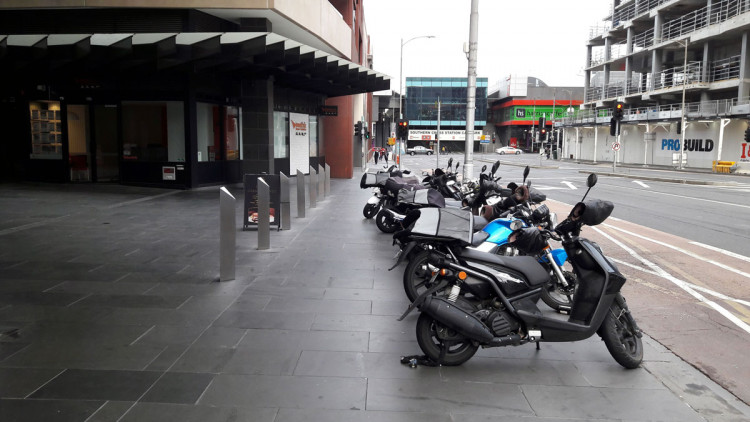
Motorcycle parking can reduce the width of the footpath – Melbourne (Jeanette Ward)
A good example of a footpath management bylaw addressing advertising signage is the Ashburton District Councils: In all cases a clear pedestrian access way not less than 2 metres wide is to be retained[5].
Self-explaining footpath paving means that the colour and/or texture of the paving changes between zones, so that businesses can easily identify where the through zone is.
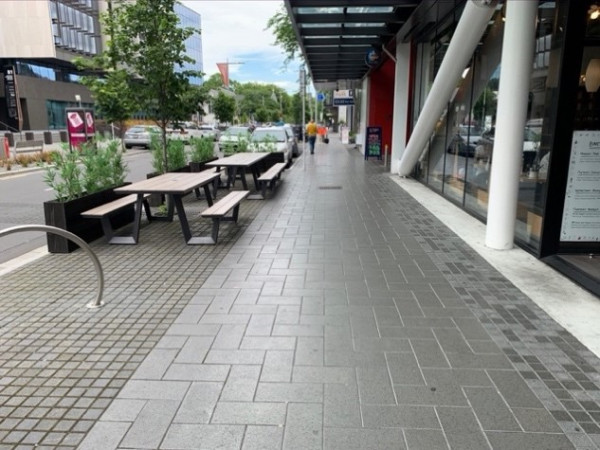
Different shades and textures of paving for each zone of the footpath – Christchurch (John Lieswyn)
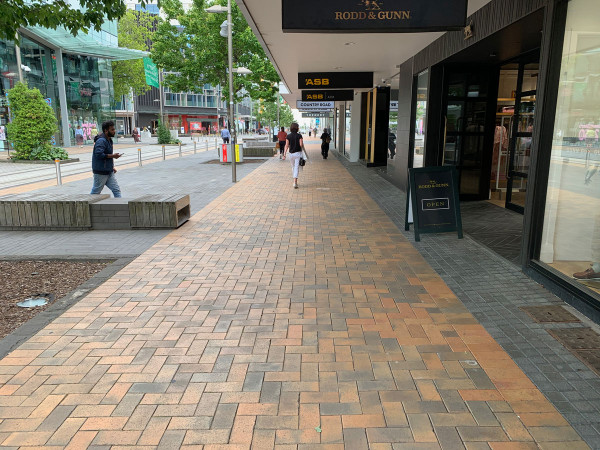
Alternative shades and textures of paving – Christchurch (John Lieswyn)
[1] Waka Kotahi NZ Transport Agency. (2020). Impact on urban amenity in pedestrian environments: A technical paper prepared for the Investment DecisionMaking Framework Review [PDF, 962 KB]
[2] Table 3.2 – Road design standards (p.66) in Standards New Zealand (2010) NZS 4404:2010 Land Development and Subdivision Infrastructure
[3] Waka Kotahi NZ Transport Agency, Road Efficiency Group (2020). One Network Framework (ONF)
[4] Figure 5.3 in Austroads (2017) Guide to Road Design Part 6A: Paths for Walking and Cycling(external link)
[5] Ashburton District Council (2017) Advertising Signage in Public Places